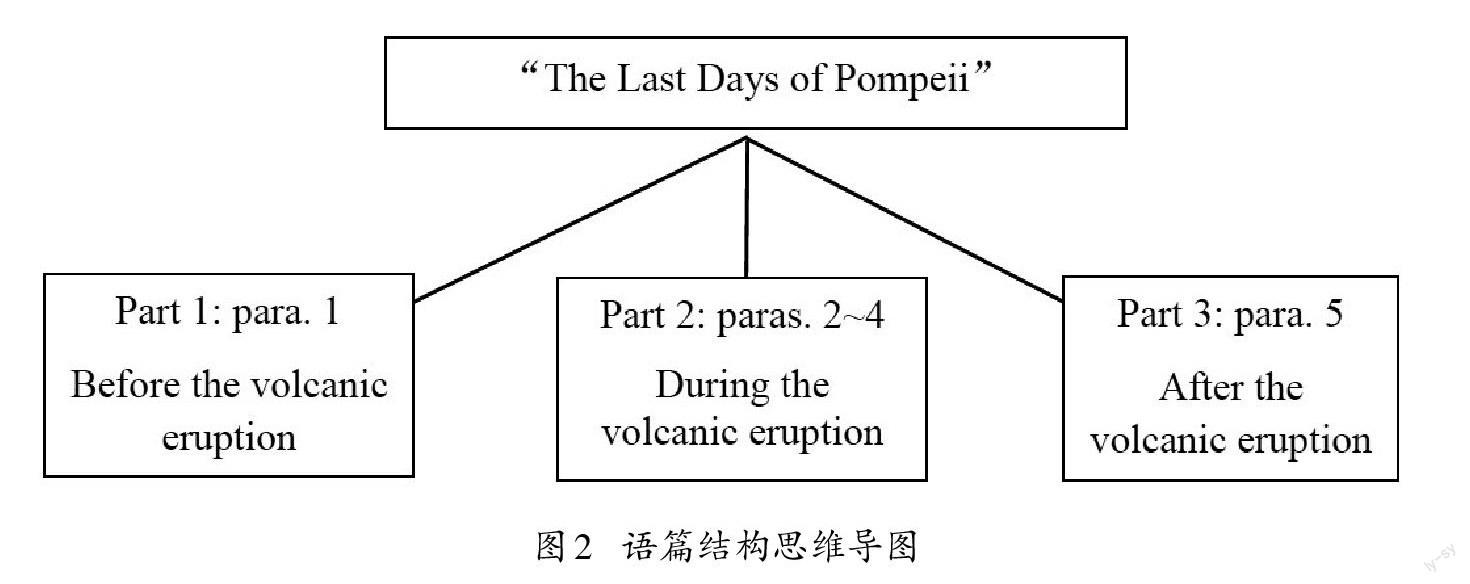模因论视域下的读后续写描写能力培养教学实践
2022-07-05刘伶
刘伶



摘 要:描写可以使记叙文更形象化和具体化,并推动故事情节的发展,进而更好地揭示主题。模因论视域下的读后续写描写能力培养可以从“模因输入,同化语言知识”“模因保持,培养语言能力”“模因输出和互动,形成语言素养”三个方面展开,以帮助学生在主题意义的探究过程中,形成同一主题的描写方法,实现知识向能力、能力向素养的转化。
关键词:模因论;读后续写;描写能力
读后续写是高考英语的新题型之一,旨在考查学生的文本解读能力、情节推理能力、细节描写能力、语篇衔接能力和创新思维能力等综合语言运用能力。读后续写的阅读材料一般以记叙文文本为主,其内容贴近生活,有一定趣味性,给学生的想象空间较大,上下文连贯性较强,语言难度较易把握[1]。记叙文的重要表达方式之一是描写,其可以使记叙文更形象化和具体化,并推动故事情节的发展,进而更好地揭示主题。描写一般包括感官描写、具象词汇和修辞手法[2]。
模因论(memetics)是一种基于达尔文进化论观点解释文化进化规律的理论,其借用生物进化模式探讨模因(meme)的复制、传播和进化。meme源自希腊语,意为“被模仿的东西”[3],其传播周期可划分为同化(assimilation)、记忆(retention)、表达(expression)和传播(transmission)四个阶段。语言学习本身就是语言模因复制、传播的过程。为此,教师应在语言教学中,为学生提供大量的语言模因输入,让学生在理解的基础上复制、模仿,并进行有效的模因输出。笔者基于模因论四个阶段的传播周期,构建了模因论视域下的读后续写描写能力培养教学模式(如图1所示),并将其应用于译林版普通高中教科书《英语》必修三第二单元Extended Reading “The Last Days of Pompeii”的教学中。“The Last Days of Pompeii”属于“人与自然”主题语境下的“灾害防范”主题群,以维苏威火山爆发前、中、后这一时间线索展开叙述,生动形象地展现了庞贝古城在狂暴自然力袭击下归于毁灭的惨象。
一、模因输入,同化语言知识
在语言教学中,模因输入是指教师根据学生的语言水平和兴趣爱好筛选同一主题的语言模因进行教学,学生运用注意、理解等手段习得语言模因,进而同化为语言知识的过程。
首先,教师呈现语篇标题和教材插图,并提出问题“What are the key words in the title?”“What can you find special in the pictures?”“What can you predict the author will introduce in the text?”,引导学生预测语篇大意,调动学生兴趣。绝大部分学生都能够推测出语篇是一篇描写维苏威火山爆发使得庞贝古城毁灭的记叙文。
然后,教师让学生快速阅读语篇获取语篇大意,并以小组为单位绘制语篇结构思维导图(如图2所示)。这一过程不仅有助于培养学生获取表层信息的能力,而且还有助于培养学生分析、提炼和概括语篇信息的能力,使学生初步感知主题意义,为下面的细节阅读作铺垫。
接着,教师按照语篇结构,采用问题链的形式,帮助学生在深层次探究语篇主题意义的同时,习得相关的描写知识。就第一部分而言,教师提出问题Q1~Q3,引导学生注意描写灾害发生前场景的方法。
Q1: What is the first part mainly about?
Q2: What was the city of Pompeii like before the volcanic eruption?
Q3: How does the author describe Pompeiis prosperity before the volcanic eruption?
Q1旨在訓练学生归纳、概括段落大意的能力;Q2旨在引导学生分析并推断文字背后的深层含义,进而结合文本理据分享对火山爆发前庞贝古城的认识;Q3旨在培养学生鉴赏文本写作技巧的能力。借助Q1~Q3,学生总结出第一部分采用具象词汇来描写火山爆发前庞贝古城的繁荣景象,凸显了画面感(如作者通过描写各种船只来体现庞贝古城发达的水上运输行业)。
就第二部分而言,教师提出问题Q4~Q6,引导学生领会如何描写灾害中的场景及人们的感受。
Q4: What is the second part mainly about?
Q5: How does the author describe the scene of the volcanic eruption?
Q6: How does the author describe peoples feelings and reactions during the volcanic eruption?
Q4旨在训练学生归纳、概括段落大意的能力;Q5和Q6旨在引导学生探究文本的写作技巧。在Q4~Q6的引导下,学生总结出第二部分采用感官描写、具象词汇和修辞手法相结合的方式来描写火山爆发时的场景及人们的感受。其中,作者采用明喻(如A moment later, the mountain-cloud seemed to roll towards them, dark and rapid, like a river.)、倒装和暗喻(如Over the empty streets — over the forum — far and wide — with many a noisy crash in the stormy sea — fell that awful shower!)三类修辞手法来描写火山爆发时的场景,采用视觉(如The crowd looked upwards, and saw, with unspeakable fear, a huge cloud shooting from the top of the volcano.)、触觉和听觉(如At that moment, they felt the earth shaking beneath their feet; beyond in the distance, they heard the crash of falling roofs.)三类感官描写来描写火山爆发时人们内心的恐惧,以及采用具象词汇(如Each turned to fly — each running, pre-
ssing, pushing against the other.)来描写人们逃亡的场景。
就第三部分而言,教师提出问题Q7~Q9,引导学生领悟如何描写灾害后的场景。
Q7: What is the third part mainly about?
Q8: What did the remains of Pompeii look like after it was unearthed?
Q9: How does the author describe the remains of Pompeii?
Q7旨在训练学生归纳、概括段落大意的能力;Q8旨在引导学生获取庞贝古城遗址的基本事实性信息;Q9旨在引导学生理解并分析作者描写事物的方法。在Q7~Q9的引导下,学生了解到庞贝古城遗址的基本事实性信息(如Its walls were fresh as if painted yesterday; not a single colour changed on the rich pattern of its floors. In its forum, the half-finished columns seemed as if just left by the workmans hand.),并推断出作者采用具象词汇(如its walls、colour和columns)和夸張修辞手法(如as if painted yesterday和as if just left by the workmans hand)相结合的方式展现了由于火山的爆发,庞贝古城在一刹那间被历史定格。
最后,教师提出问题“Why does the author write the descriptive writing?”,让学生四人一组进行讨论,引导学生在把握作者写作意图的基础上,进一步探究语篇的主题意义。学生在思维碰撞中意识到灾害给人类带来的巨大伤害,对自然产生敬畏之心。
经过层层递进,环环相扣的模因输入,学生在感知语篇主题意义的同时,初步形成了关于“灾害防范”的描写方法(如图3所示)。具体而言,学生可以单独使用具象词汇来描写灾害前的场景,综合使用感官描写、具象词汇和修辞手法来描写灾害中的场景及人们的感受,交叉使用具象词汇和修辞手法来描写灾害后的场景。
二、模因保持,培养语言能力
在语言教学中,模因保持是指教师使用教学策略,指导学生有意识地运用记忆和学习策略,加强和巩固输入的语言模因,使之能长时间地停留在记忆中,进而促进知识向能力的转化。在这一环节,教师运用合作学习和情境教学策略,为学生提供同一主题的语言模因操练机会,以使学生实践与内化所获得的语言知识。
首先,教师让学生两人一组概述“The Last Days of Pompeii”,旨在引导学生熟悉、巩固在模因输入环节习得的语言知识并体会作者所传达的主题意义。在该任务中,学生运用所梳理的结构化知识,概述维苏威火山爆发前、中、后庞贝古城的场景和火山爆发时人们的感受,体会到作者借此描写所展现的灾害的巨大破坏力。
然后,教师呈现本单元Reading板块“Girls saves 100 from tsunami”中的海啸插图,让学生运用所学的关于“灾害防范”主题的语言模因来描写海啸发生时的场景和人们的感受。一名学生的产出如下:
The sea suddenly disappeared. Boats were stranded on the reef. Sea fish leapt out of the sea and landed on the rocks. Then the sea water surged forward and came back. The water was like the bubbles on the top of a beer. It was just coming in and in and in. Huge waves shot to the shore at a great speed, sending boats and cars crashing into nearby villages. People fled to the higher ground, screaming for help. They tried to resist the water but felt like tsunami would drag them back to the sea.
上述两个任务不仅可以训练学生的精细加工策略,还可以使“灾害防范”主题的语言模因在反复应用后被保持在学生的记忆中,促进学生知识向能力的转化。
三、模因输出和互动,形成语言素养
为了帮助学生有效地表达和广泛地传播同一主题的语言模因,促进学生语言能力向语言素养的转化,教师应实施模因输出和模因互动两个教学环节。
(一)模因输出
在语言教学中,模因输出是指教师基于同一主题设计写作任务,让学生运用同一主题的语言模因进行写作。学生根据写作要求,调取储存在大脑中的同一主题的语言模因进行模因输出。
在这一环节,教师基于学生的生活实际,呈现一篇“灾害防范”主题的阅读文章,让学生用灾害防范的描写方法进行读后续写。语篇描述了暴风雨发生前的场景,讲述的是主人公Sarah在暴风雨来临前没有像其他人一样储备食物。由续文第一段首句“Obviously, a storm was on its way.”可以推出,该段需要学生描写暴风雨中的场景和人们的感受;由续文第二段首句“Trapped at home, Sarah wondered how she could survive.”可以推出,该段需要学生描写Sarah如何获救及暴风雨后Sarah家的场景。
一名学生的习作如下:
Obviously, a storm was on its way. ① Sarah looked upwards, and saw, with unspeakable fear, a tornado twirling in the distance like a gray funnel. ② A sudden burst of lightning drew lines in the black clouds, lighting up the dark sky. ③ In an instant, rain began to pour down, beating heavily against the window. ④ People turned to fly — each running, pre-
ssing, pushing against the other. ⑤ So came the storm, and so ended Sarahs hope.
Trapped at home, Sarah wondered how she could survive. ⑥ Then, her dogs sudden bar-
king attracted her to the window, where there was a lot of food with a note from her neighbour, explaining that she had purchased enough food. ⑦ After the storm, her front garden had been flooded. ⑧ Vegetables and flowers lowered their heads as if dead. ⑨ Trees were snapped in two and rubbish scattered everywhere. ⑩ But it was human kindness that burnt bright.
(二)模因互動
在语言教学中,模因互动通常情况下是指教师引导学生对模因输出展开评价。在这一活动中,教师不仅应对学生的模因输出进行评价并给出建议,还要引导学生进行互相评改、自我评改[4]。
小组写作评价活动可“发挥评价的激励作用和促学功能,对英语教学形成积极正面的反拨作用”[5]。因此,教师设计了写作评价表(如表1所示),让学生以小组为单位展开评价。表1主要考查学生使用“灾害防范”主题的感官描写模因、具象词汇模因和修辞手法模因情况。
根据表1,学生认为上文的习作使用了“灾害防范”主题的感官描写模因、具象词汇模因和修辞手法模因,使得读后续写主题更鲜明,情节更符合逻辑,语言更丰富多彩。具体
评价如下:一是在描写暴风雨中的场景和人们的感受时使用了视觉描写(如句①),明喻修辞、拟人修辞和倒装修辞三种修辞手法(如句①②⑤)以及具象词汇(如句①的unspeakable和twirling,句③的beating,句④的fly、running、pressing和pushing);二是在描写暴风雨后Sarah家前院的场景时使用了具象词汇(如句⑧的vegetables、flowers和lowered,句⑨的trees、snapped、rubbish和scattered),拟人修辞、夸张修辞两种修辞手法(如句⑧)。正是有了这些描写语言模因的使用,该习作凸显了灾害面前人性的温暖,成功地进行了一次模因输出。
借助模因论培养学生的读后续写描写能力为读后续写教学提供了新方法。在模因论视域下,教师让学生意识到读后续写的叙事方式并非只是平铺直叙,而是可以运用同一主题的感官描写模因、具象词汇模因和修辞手法模因进行描写,以使文章情节更加生动、主题更加鲜明。模因论视域下读后续写描写能力培养的四个阶段是环环相扣、层层递进的:模因输入有助于学生理解同一主题的语言模因,同化语言知识;模因保持可以帮助学生记忆同一主题的语言模因,培养语言能力;模因输出和模因互动能够让学生创造性地使用同一主题的语言模因进行输出,并开展评价活动,形成语言素养。这一过程有助于学生在主题意义的探究过程中,形成同一主题的描写知识,实现知识向能力、能力向素养的转化。
参考文献:
[1]刘庆思,陈康.关于一年两考高考英语试卷中读后续写设计的研究[J].中小学外语教学(中学篇),2016(1):1-5.
[2]SURIYANTI S, YAACOB A. Explo-
ring teacher strategies in teaching descriptive writing in Indonesia[J]. Malaysian Journal of Learning and Instruction, 2016(13): 71-95.
[3]何自然.语言中的模因[J].语言科学,2005(6):54-64.
[4]李登忠.基于模因论的高中英语写作教学研究[J].英语教师,2020(18):55-57.
[5]中华人民共和国教育部.普通高中英语课程标准(2017年版2020年修订)[S].北京:人民教育出版社,2020:81.
附:“灾害防范”主题阅读文章及读后续写要求
阅读下面材料,根据其内容和所给段落开头语续写两段,使之构成一篇完整的短文。
When there was news that a storm was coming, Sarah didnt think much about it. She simply shrugged it off like any other normal day. When she went to the grocery store and saw that it was full, she still didnt worry.
People ran like mad between aisles (过道), grabbing what they could. Bare shelves and long lines made Sarah chuckle (窃笑). They must be overreacting, she thought.
On her way home, she looked overhead. Dark clouds were indeed forming. And they seemed to be moving quickly across the sky. Still, Sarah was not bothered. The rain would be nice since it had been warm lately.
When she got home, Sarah made popcorn and sat on the sofa with her dog, Cooper, and got ready to watch a movie.
Just as she hit play on the remote, she heard the thunder. Rain started to come down hard, making it almost impossible to see the trees in her front garden through the window. Cooper immediately jumped from the sofa, barking in fear in the corner.
“Its OK.” Sarah said. She moved to one side and saw Cooper looked a bit nervous. Sarah turned off the movie and instead skipped to the local news station. The storm was much more serious than she had thought. People in a nearby city even said they spotted a tornado. The repor-
ter advised people to stay inside and secure all of the doors and windows.
Sarah got up and began making her way around the house. Cooper followed behind as she checked all of the windows to make sure they were all fully closed. By the time she got back to her sofa, the rain had stopped. “That wasnt so bad,” Sarah said aloud, “Just a nice shower.”
She turned to cooper, who had gone back to the corner and still looked a bit frightened. She looked outside. It was actually very calm, but she could see that the wind was picking up. The branches of the trees were swinging and the garbage bin had tipped over.
注意:
1.續写词数应为150 左右。
2.请按如下格式进行续写。
Obviously, a storm was on its way.
Trapped at home, Sarah wondered how she could survive.
